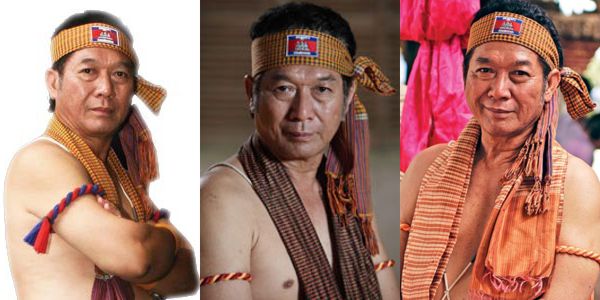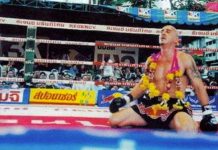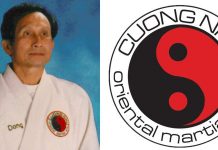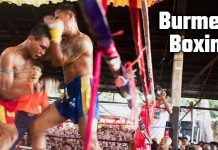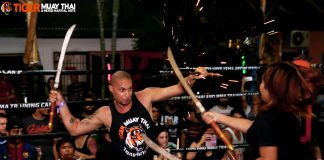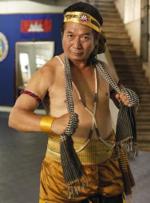 Grand Master San Kim Sean shares about Khmer Bokator, The Ancient Form of Cambodian Martial Arts.
Grand Master San Kim Sean shares about Khmer Bokator, The Ancient Form of Cambodian Martial Arts.
“We can fight standing up.” Explained San Kim Sean, Grand Master of Khmer Bokator. At more than sixty years old, he looked as if he was in his forties, but moved like a man much younger. He threws a kick at me, similar to the round house, used in Khmer Boxing. The kick missed, and his kicking leg landed to the side of my body. With the ease of forty years of martial arts practice, he shifted all of his weight forward, onto his kicking leg. Not more than a few inches to my side, he hooked his rear foot around, and kicked me square on the jaw.
“The dragon whips his tail.” He said, sounding like a Bruce Lee movie.
Next, he dropped to his knees, and executed an elbow strike in an upward motion, to my solar plexus. “We can fight on our knees.” He said. He dropped to the ground and trapped the kick I had thrown at his face. “We can fight from sitting.” Next, he prostrated his body, and dragged my ankle, causing me to topple to the ground. “ We can even fight laying down.” He laughed.
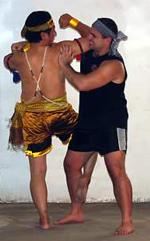 Khmer Bokator is a very complete martial art, which uses strikes, drags, trapping, and locking for both offense and defense. In Khmer Bokator, the entire body is used as a weapon. Many martial arts use a head but, but some of the techniques which San Kim Sean showed me used the jaw and even the shoulder muscle as weapons.
Khmer Bokator is a very complete martial art, which uses strikes, drags, trapping, and locking for both offense and defense. In Khmer Bokator, the entire body is used as a weapon. Many martial arts use a head but, but some of the techniques which San Kim Sean showed me used the jaw and even the shoulder muscle as weapons.
“The lion has fangs.” He explained. “We also use fangs in our fighting.” San Kim Sean made a fist, then extended his pointer finger, bending it at the second joint. With pinpoint accuracy, he used this “fang” to stab me in the pressure point behind the clavicle. Needless to say, it was quite painful. “If we train long enough, we can make the finger go through the flesh.” He said with a likable, but sadistic grin. “And then we can rip out that bone.” He showed me how the finger would extended, wrap around the collarbone, and then how hi hole body would be used to jerk it out.
“Do you believe that your art I better than Khmer Boxing?” I asked.
“Of course.” Answered San Kim Sean, without hesitation.
“Do you mean that one of your students could get in the ring with the champion, Eh Phou Thoung right now and win?” I asked, skeptically.
“My students would never b allowed to fight in the ring.” He explained. “We are trained to kill.”
San Kim Sean asked one of his young students to attack him in a boxing stance. When the student threw a punch, San Kim Sean countered with an elbow strike to the student’s throat. “KILL!” shouted San Kim Sean. The student threw a second punch, this time, San Kim Sean stabbed the student in the throat with his fingers. “KILL!” he yelled again. The student kicked, and San Kim Sean hit the student’s thigh with his knee, knocking the student to the ground.
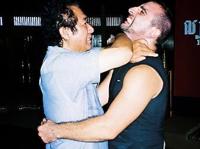 The student leapt to his feet, and clinched with the teacher, hitting him with knee strikes. San Kim Sean crisscrossed his forearms over the students throat, and, like a pair of scissors, he crushed the student’s windpipe with his wrist bones. “Kill!” he yelled again. Next, he rotated the wrist bones away from the student’s throat, but careful to keep the student’s neck locked in hi vice-like forearms. “This one not kill.” He explained. Pulling the student in close, he smashed his shoulder up into the student’s jaw. It was obvious that if he had done it full force, the student would have been knocked unconscious. Finally, he drove the heel of his foot into the inside of the student’s thigh, driving him to the canvass again.
The student leapt to his feet, and clinched with the teacher, hitting him with knee strikes. San Kim Sean crisscrossed his forearms over the students throat, and, like a pair of scissors, he crushed the student’s windpipe with his wrist bones. “Kill!” he yelled again. Next, he rotated the wrist bones away from the student’s throat, but careful to keep the student’s neck locked in hi vice-like forearms. “This one not kill.” He explained. Pulling the student in close, he smashed his shoulder up into the student’s jaw. It was obvious that if he had done it full force, the student would have been knocked unconscious. Finally, he drove the heel of his foot into the inside of the student’s thigh, driving him to the canvass again.
“You see?” He asked me. “You would never be allowed to o any of that in a boxing ring. But it is very effective.”
The student returned to his practice. He would leap I the air, and kicking the heavy bag with both feet. Each time he landed, he would be lying on the ground, in a controlled stance, ready to fight.
“That boy has only been with me one year.” Said San Kim Sean, with pride. “But he already knows three hundred techniques. And now, he can help me teach the other students.”
San Kim Sean explained to me why it was so important to him to pass on the art.
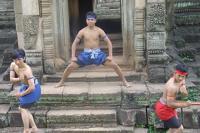 Bokator is the ancient Khmer martial art, the predecessor of Brodal Serey (Khmer Free Boxing). Today, the name, Brodal Serey has been lost to the world, having been replaced by the word Muay Thai. “The Thais stole our art.” Say many Khmers, who believe that the bas-reliefs carved on the walls of Angkor Wat temple prove that the origin of Khmer Boxing predates Muay Thai.
Bokator is the ancient Khmer martial art, the predecessor of Brodal Serey (Khmer Free Boxing). Today, the name, Brodal Serey has been lost to the world, having been replaced by the word Muay Thai. “The Thais stole our art.” Say many Khmers, who believe that the bas-reliefs carved on the walls of Angkor Wat temple prove that the origin of Khmer Boxing predates Muay Thai.
While the name may have been stolen, the art of Khmer Boxing is very much alive, and thriving as a professional sport, enjoyed all around the world. This, unfortunately is not the case for the much older art of Bokator Khmer. This art is nearly unknown, even in Cambodia. “Outside of Cambodia, the only thing people know is Angkor Wat.” Said San Kim Sean “They don’t know about our martial art.”
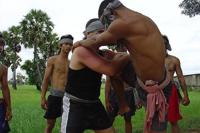 Bokator Khmer uses colored Krama (traditional Khmer scarves) instead of belts. The art contains ten animal styles. The five white krama animal forms include: king monkey, lion, elephant, apsara (traditional Hindu sacred nymph), and crocodile. The green krama forms include: duck, crab, horse, bird, and dragon.
Bokator Khmer uses colored Krama (traditional Khmer scarves) instead of belts. The art contains ten animal styles. The five white krama animal forms include: king monkey, lion, elephant, apsara (traditional Hindu sacred nymph), and crocodile. The green krama forms include: duck, crab, horse, bird, and dragon.
San Kim Sean began training in Bokator Khmer when he was just thirteen years old. According to him, even at that time the art was not very common. “Only a few old men knew the art.” It was still practiced in some of the provinces, but was unknown in the capital. His uncle, a friend of his father, taught him to fight with his hands. Another “uncle” taught him to use the long staff. And yet another, taught him to use the two traditional Khmer long swords, called dao.
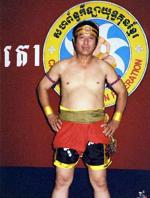 San Kim Sean was always interested in martial arts, so he practiced Khmer boxing for three years. Later, he earned belts in Judo, Karate, and became only one of three Khmers to earn a blackbelt in Hopkido. “I was third dan.” He told me.
San Kim Sean was always interested in martial arts, so he practiced Khmer boxing for three years. Later, he earned belts in Judo, Karate, and became only one of three Khmers to earn a blackbelt in Hopkido. “I was third dan.” He told me.
Unfortunately for him, 1975, the year he became an instructor of Hop Kido, was also the year that Phnom Penh fell to the Khmer Rouge, under the leadership of Pol Pot. The city was ordered to evacuate, and the entire country was collectivized, forced to do backbreaking physical labor, with only a few hours of sleep per day, and very little food.
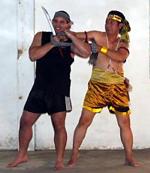 “I don’t have to tell you the Pol Pot time was bad.” Said San Kim Sean. “Everyone knows.” He shook his head sadly. “My group began with 10,000-13,000 people. Two years later, only five hundred were still alive. They were either murdered or died of hunger.” Two of San Kim Sean’s children died at the hands of the Khmer Rouge.
“I don’t have to tell you the Pol Pot time was bad.” Said San Kim Sean. “Everyone knows.” He shook his head sadly. “My group began with 10,000-13,000 people. Two years later, only five hundred were still alive. They were either murdered or died of hunger.” Two of San Kim Sean’s children died at the hands of the Khmer Rouge.
Although everyone suffered, and anyone, including Khmer Rouge soldiers and cadre were potential victims of execution, certain groups were singled out for extreme persecution and extermination. Among them were the Cham, Cambodian Muslims, Chinese, Vietnamese, educated people, people with classes, anyone with knowledge of English or French, the literate, artisans, and skilled workers. Pol Pot had declared a Year Zero, as a symbol of his desire to break with the past. To this end, he hunted down and killed masters of traditional Khmer arts including singing, dancing, and martial arts.
“All of my students and training bothers died.” He told me. “And, I was the only Hopkido instructor who suvived.”
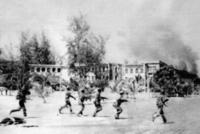 In 1979, The Khmer Rouge regime fell to an invasion by the Vietcong. San Kim Sean came back to Phnom Penh, and began teaching Hop Kido. The Vietnamese regime, which, arguably, was only slightly better than the Khmer Rouge, prohibited the Cambodians from practicing martial arts. “I was teaching in secret. But some Khmer person who was jealous of me, turned me into the Vietnamese authorities.”
In 1979, The Khmer Rouge regime fell to an invasion by the Vietcong. San Kim Sean came back to Phnom Penh, and began teaching Hop Kido. The Vietnamese regime, which, arguably, was only slightly better than the Khmer Rouge, prohibited the Cambodians from practicing martial arts. “I was teaching in secret. But some Khmer person who was jealous of me, turned me into the Vietnamese authorities.”
The Vietnamese said that San Kim Sean was trying to build an army or had some other subversive goal in mind. He would have been jailed, but he and his wife escaped to a refuge camp in Thailand.
They spent one year in Nokor Siclium camp, where his wife gave birth to a daughter, named Bopa. Eventually, in 1980, their paperwork came through, and the family was allowed to relocate to the USA, settling first in Houston, Texas, where San Kim Sean found a good job at the airport. He also taught Hop Kido to the Khmer children at the YMCA. Life was good for San Kim Sean and his family, but he missed his culture. On a vacation to the Khmer community in Long Beach, California, he was amazed at the Khmerness of the place.
“The shops had Khmer writing on them. I saw women wearing sarongs. They had Khmer restaurants.” Laughed San Kim Sean. “I said, hey, this is my country.”
And so, he quit his job, and moved to Long Beach. Eventually, he found work dubbing Khmer voice-overs on Chinese action movies. And, he continued teaching Hop Kido.
“This is all very interesting.” I said, and I meant it. Here was a man who had overcome great odds, for both the love of martial art and the love of his people. “But, your story is all the way up to 1990 and you don’t seem to be teaching Bokator to anyone.”
“That will come later.” San Kim Sean laughed. “I have to tell you the whole story first.”
To be a good martial arts student, you have to have patience.
“I took my Hop Kido students all over for competitions. And, I never once heard the words Bokator Khmer. In fact, no one knew anything about any Khmer martial arts at all.”
By this time, San Kim Sean was a tenth degree black belt in Hop Kido. “I began to wonder.” He told me. “Why am I out doing all of this advertising for a Korean art?”
He explained to me that Bokator Khmer is an ancient art, predating even the 1000 year-old carvings at Angkor Wat. King Jayavaraman VII, the creator of Angkor Wat is depicted in a stance, with the Khmer short sword, the dao. “Do you know why he was such a good king and why he kept Cambodia safe? It was because he was a martial artist. He knew Bokator Khmer.”
“At that time, there were no rockets, no guns, only fighting swords and hands and feet. And the Khmers could win because our soldiers were trained in Bokator.”
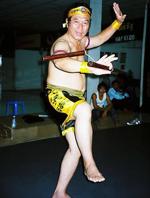 San Kim Sean explained why the martial art, which was once so proud and strong, had already faded into near extinction before the Pol Pot regime. “The masters never taught all of their art to a student. They always held back about ten percent, in case a student ever attacked them.”
San Kim Sean explained why the martial art, which was once so proud and strong, had already faded into near extinction before the Pol Pot regime. “The masters never taught all of their art to a student. They always held back about ten percent, in case a student ever attacked them.”
If each progressive generation learned ten percent less than the previous generation, it is no wonder that the Khmer martial arts were on a downward slide.
“Khmer young people don’t even know their own history. They don’t know about our greatness in the past, the ancient arts which were taught by the grandfathers’ grandfather, which is running in our blood.”
San Kim Sean told me that he began having nightmares about Cambodia. “It was God telling me I needed to come home and help the Khmer people.”
During the early 1990’s he returned to the stricken land to help rebuild the Khmer Hop Kido Association.
“We still aren’t talking about Bokator.” I reminded him.
“And you still have to wait.” He told me, in his friendly tone.
Finally, in 1995, he moved back to Phnom Penh, became the leader of the Hop Kido Association, and began teaching Hop Kido.
“But, Bokator…” I protested.
He waved his hand dismissively, and continued with the story. “Finally, in 2001, I left the Hop Kido school, an began teaching Bokator.” San Kim Sean is still a respected officer of the Hop Kido association. But, his true love is Bokator. And now he dedicates all of his time to this pursuit.
He began combing the countryside, looking for Bokator Masters who had survived the Khmer Rouge and the Vietnamese Regime. “They were old. Many of them between sixty and ninety years of age.”
The number of masters remaining was very small. And of that number, none were teaching. After being repressed under both the Khmer Rouge and the Vietnamese regime, the men were afraid to start teaching.
“I tried to tell them it was OK, we already had permission from the government, but they wouldn’t listen.” Said San Kim Sean. The old men wanted to stay in the province. But San Kim Sean insisted. “You have a great gift which was given to you by our ancestors. Do you want to steal it from our children? When you die, the art will die with.”
“Did it work?” I asked.
“Some of them broke down in tears.” Laughed San Kim Sean, who seemed like he could be persuasive when he needed to. “In April of 2004 we held the first Bokator conference in Phnom Penh. Now, there are schools in eight provinces. And, we are preparing for a national championships.”
Most martial artists in the west can’t be bothered to practice. Here was a man who had risked his life to preserve the arts. And more recently, had given up a well paying job I America in order to come back to Cambodia and help recover a lost art.
“I really respect what you have done here.” I told San Kim Sean. But the interview was finished, and now h wanted to kick me in the head some more.
The Bokator association needs financial support, as well as equipment. San Kim Sean has prepared what is probably the first ever Bokator textbook, written by a Khmer, in Cambodia. “We want to produce ten thousand books, and give them to school children.” He told me sadly. “But we have no money.”

